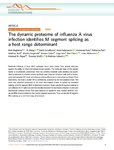The dynamic proteome of influenza A virus infection identifies M segment splicing as a host range determinant
Bogdanow, Boris
Wang, Xi
Eichelbaum, Katrin
Sadewasser, Anne
Husic, Immanuel
Paki, Katharina
Budt, Matthias
Hergeselle, Martha
Vetter, Barbara
Hou, Jingyi
Chen, Wei
Wiebusch, Lüder
Meyer, Irmtraud M.
Wolff, Thorsten
Selbach, Matthias
Pandemic influenza A virus (IAV) outbreaks occur when strains from animal reservoirs acquire the ability to infect and spread among humans. The molecular basis of this species barrier is incompletely understood. Here we combine metabolic pulse labeling and quantitative proteomics to monitor protein synthesis upon infection of human cells with a human- and a bird-adapted IAV strain and observe striking differences in viral protein synthesis. Most importantly, the matrix protein M1 is inefficiently produced by the bird-adapted strain. We show that impaired production of M1 from bird-adapted strains is caused by increased splicing of the M segment RNA to alternative isoforms. Strain-specific M segment splicing is controlled by the 3′ splice site and functionally important for permissive infection. In silico and biochemical evidence shows that avian-adapted M segments have evolved different conserved RNA structure features than human-adapted sequences. Thus, we identify M segment RNA splicing as a viral host range determinant.

